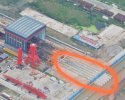Another image, another excuse for measurements.
Numbers around the carrier represent pixels counts on the lines drawn.
Bigger numbers near the top and bottom of the image are also pixel counts, divided by smaller numbers which are meters, as measured in GE.
Interesting to note is the rather big difference in ratios. Using the bottom of the image structure, each 3.58 pixels represent one meter. But using the road marks on the top of the image, one gets just 2.67 to 2.78 pixels per meter.
So, unless I've made some error somewhere, there is somehow some distortion due to lens or whatever. I will thus go with a dangerous assumption: for the mid body lines, which are roughly in the middle of the two size references, i will use an average of the ratios: 3.15 pixels per meter. For the lines on the ship more to the left of the image, reading 102 and 58 pixels, I will use a ratio closer to the road reference, at 2.95 per pixel.
Using those, I get the following: the line that's 102 pixels long may be 34.6 meters long. That might be the width of the hull at that point.
The line that's 115 pixels long may be 36.5 meters long.
I do believe the small curved red line on the ship that i added is the elevator opening. The size and the curve fits. Even the height from the ground seems to fit. The only thing not fitting is the width of the hangar. Which appears to be just 19.7 meters at that point. Unless that's some smaller part of the hangar which is unusually narrow, and rest of the hangar is wider, that width doesn't mesh with any other known hangar dimension of known carriers comparable in size.
Anyway, feel free to provide different measurements.







